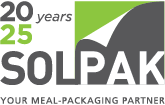Finding a solution to seal your ready meals is no easy task. Between the different options available to you, your needs and those of your customers to consider, you could soon find yourself overwhelmed!
To make it easier for you, we have identified 7 advantages of heat sealing compared to sous vide to help you make a decision.
Just to let you know that in this article we only compare 2 ways of sealing your meals: vacuum sealing, an essential step in the way of cooking sous vide which requires that the food be cooked in a plastic pouch; with the sealing of individual meals.
1. HIGHER PRODUCTION SPEED (MUCH HIGHER EFFICIENCY)
Even with a manual device, heat sealing is at least 2 to 5 times faster, depending on the sous vide equipment.
With a manual heat sealer, it is possible to package 8 meals per minute without straining yourself. In comparison, it takes 10 to 30 seconds (and sometimes longer, depending on the equipment) to seal a single meal sous vide, and this, only once the food has been inserted in the bag and placed in the sous vide machine.
In higher production, an automated heat sealer can seal up to 34 meals per minute. To seal an equivalent number of meals would require several sous vide sealers.
For industrial production, specialized heat sealers also produce significantly higher output and efficiency.
2. LESS INITIAL INVESTMENT
The investment required for heat sealing equipment compares very favourably to commercial sous vide equipment.
In addition, our equipment operates on 110 volts, which is not always the case for sous vide equipment. This saves you an expensive electricity bill.
3. CHEAPER TO USE
The film required for sealing is always included in the price of the trays (including shipping). This represents approximately $0.03 per unit.
Small sous vide bags purchased separately from the trays, which are typically more expensive, that is strong enough, are usually more expensive. For larger dishes, vacuum bags can cost several times the price of the film.
4. BETTER PRESENTATION
During the sous vide process, sauces and liquids try to follow the air that is removed, often spoiling the appearance of the meals. If the trays are not very resistant, they too get damaged, which is not good for your food.
5. EASIER TO HANDLE FOR THE CUSTOMER
The customer buying a heat-sealed, ready-made meal does not have to remove a corner of the film or make an incision to put the meal in the oven or microwave.
While the sous vide customer has to struggle with his scissors to remove the bag covering the meal.
7. MORE ECOLOGICAL
The film covers the top of the tray only, instead of completely surrounding the tray. Less material to produce, transport, and recycle.
The film can be rinsed off more easily than sous vide bags and therefore customers are more likely to recycle them.
Heat sealing is typically done using a tray made from a renewable source, often recovered and compostable in addition to being recyclable. These trays are not composed of hydrocarbons as are the plastic dishes so often used in sous vide packaging.
7. LESS MAINTENANCE
Heat sealers require less maintenance than more complicated sous vide machines. On a daily basis, cleaning the plate and the tray of the heat sealer is a minor task and definitely easier and quicker than cleaning the vacuum sealer, especially as the food tends to leak often while being operated.
Eager to find out more about heat sealing? Discover our Solpak Tray Sealers.
